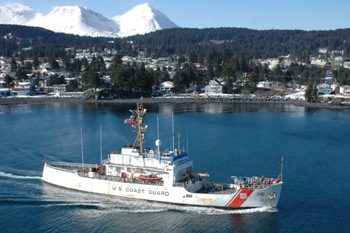USCGC Storis (WMEC-38) (Custody ship)
The U.S. Coast Guard cutter (USCGC) Storis was commissioned in 1942 and designed to operate in the waters around Greenland as a supply vessel with moderate ice-breaking capability. During World War II, Storis, stationed at Boston, Massachusetts, operated chiefly in the North Atlantic, breaking ice, escorting convoys, and conducting patrols. In 1957 Storis, along with CGCs Bramble (WLB-392) and Spar (WLB-403), discovered a deep draft channel through the Arctic Ocean, establishing a path for the long-sought Northwest Passage. Upon its return to the waters off Greenland, Storis became the first vessel to circumnavigate the North American continent. In late 1957, the cutter was reassigned to Kodiak, Alaska. Once it was in Alaskan waters, Storis’s primary responsibilities shifted to enforcing the laws and treaties of the fisheries of the Bering Sea and the Gulf of Alaska; throughout the late 1960s, interceptions of illegally operating foreign fishing vessels accounted for the bulk of Storis’s activity. In 1972, the vessel underwent a major renovation, and was converted from a light icebreaker to a medium endurance cutter. In 1975, Storis carried vital supplies to Prudhoe Bay for the construction of the Trans-Alaska pipeline. In 1992, the cutter called at Petropavlovsk, on the Russian Kamchatka Peninsula, becoming the first foreign military vessel to enter the port since the Crimean War in 1854. The Coast Guard decommissioned Storis in 2007; at the time, it was the oldest commissioned cutter in the Coast Guard fleet at 64 years, 5 months.
